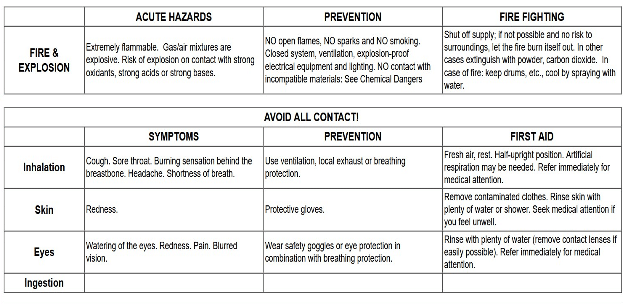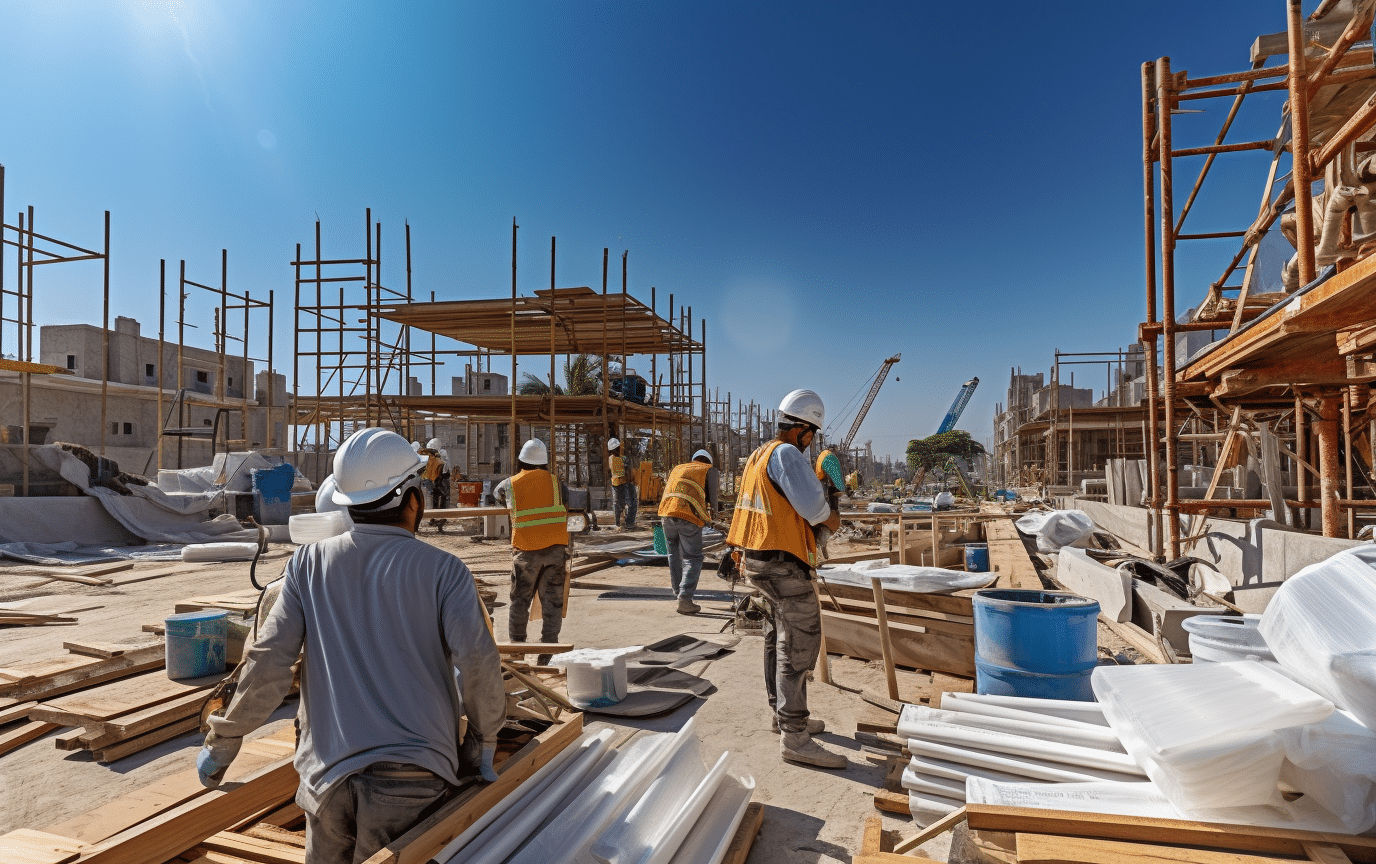- Formaldehyde, a natural gas found forming in people and the environment, can become harmful if its levels rise even by trace amounts.
- Chronic repeated exposure makes people more sensitive to its effects and can lead to cancers.
- The factories producing products for building and construction are exposed to this gas the most and have recorded some of the highest formaldehyde exposure levels.
- Therefore, employers in the construction and building industries must monitor the air in their factories and provide proper protective gear to safeguard their workers’ health.
No levels of formaldehyde are considered safe by some scientists. Even though the permissible limit by OSHA is 0.75 ppm, its recommended action levels for controlling the gas and treating workers are set at lower concentrations of 0.50 ppm. Therefore, formaldehyde detection calls for objective precision instruments. Find out more about the safety issues surrounding formaldehyde.
Formaldehyde Use in Building and Construction Industry
Formaldehyde (CH2O), a colorless gas with a strong odor, is found naturally and in many industrial products. It is produced as a liquid called formalin or a solid, paraformaldehyde. A volatile organic compound (VOC) turns into gas at room temperature.
It is usually present in low levels less than 0.03 parts per million (ppm) outdoors and indoors. Indoor spaces will have higher levels of the gas as they contain items made of formaldehyde, which escapes from the products, leading to levels above 0.03 ppm. Formaldehyde levels also change due to season, time of day, temperature, and humidity. Warm and humid weather increases formaldehyde levels.
The gas can become an occupational hazard in the many industries it is used in. The construction industry is the single largest consumer, using 60-70 percent of formaldehyde in the U.S. Implementing formaldehyde detection strategies is crucial given that formaldehyde is converted to other compounds in a diverse range of products before its end use.
Construction Products
Formaldehyde is produced industrially from fossil fuels to manufacture resins, glues, and other materials for building products that are widely used.
- Resins create laminate countertops, cabinetry, furniture, moldings, flooring, stair systems, wall sheathing, support beams, etc.
- Formaldehyde glues and binders produce composite wood, particle board, insulation, and other products.
- Formaldehyde is a feedstock for making polyurethane to manufacture insulation foams and hard plastics.
Formaldehyde Exposure in the Construction Industry
Formaldehyde exposure varies based on industries and is decreasing due to awareness of the problems created by the gas.
- For example, in Germany in 1980, 40 mg/m3 was measured in the particle board factories before any measures were taken to reduce formaldehyde.
- Around 1987, factories producing formaldehyde resins had a higher concentration of the gas in the factory air – 1 to 10 ppm (1.2 to 12.3 mg/m3).
- In 2001, phenol-formaldehyde resin processing units in Poland recorded air exposures of 0.07–0.197 mg/m3.
- Formaldehyde exposure data collected between 1979 and 2001 for the U.S. Integrated Management Information System shows that exposure levels have fallen. In 2001, time-weighted average (TWA) geometric mean exposures were highest (0.20 mg/m3) in the flooring, structural wood, and reconstituted wood industries. The reconstituted wood sector also recorded the highest short-term geometric mean exposure of 0.35 mg/m3.
These industries make up a significant proportion of the construction and building sector. Therefore, employees involved in their production must use formaldehyde detection to be protected from these health risks.
Health Concerns of Formaldehyde
Workers could inhale formaldehyde gas or encounter the liquid absorbed through the skin.
- If formaldehyde levels go above 0.1 ppm in the air, it can cause nausea, watery eyes, skin rashes, coughing, wheezing, chest tightness, allergenic reactions, and burning sensations in the nose, eyes, and throat. As a liquid, it can affect skin or mucous membranes and be very toxic if swallowed.
- In concentrations over 2 ppm, formaldehyde is corrosive. Eyes are vulnerable and become irritated.
- Over 20 ppm of formaldehyde can cloud the cornea in the eye. It can also cause allergic reactions, diarrhea, vomiting, and eye and skin irritation.
- Exposure to levels over 25 ppm in the air can cause serious harm like fatal pulmonary edema.
The health problems specific to each organ that formaldehyde exposure causes are listed in Table 1.
Chronic Risk
Recurrent exposures, even at low concentrations, can produce symptoms quicker than single higher doses, so workers exposed to formaldehyde are especially vulnerable. Repeated prolonged exposure sensitization in individuals makes them prone to asthma attacks and contact dermatitis.
The International Agency for Research on Cancer has classified formaldehyde as a Group 1 carcinogen based on leukemia and nasopharyngeal cancer studies. The World Health Organization (WHO) also considers formaldehyde a human carcinogen.
Studies have found that industrial workers exposed to high formaldehyde levels had myeloid leukemia and rare cancers of the nasal cavity, paranasal sinuses, and nasopharynx.
Formaldehyde exposure also has reproductive effects such as low birth weights, spontaneous abortions, infertility, congenital malformations, and endometriosis.
Other Risks
The gas is also an environmental pollutant as it reacts with other chemicals to form carbon monoxide, leading to acid rain. Formaldehyde is one of the constituents of smog and forms ground-level ozone. Therefore, the US EPA has designated formaldehyde a Hazardous Air Pollutant under the Clean Air Act.
Formaldehyde liquid is very reactive with oxidizers and is combustible in high concentrations. In its gaseous form, it mixes with other gases to form explosive mixtures, posing a fire and explosion risk.

Table 1: Formaldehyde risks and precautions, International Labor Organization. (Credits: https://www.ilo.org/dyn/icsc/showcard.display?p_card_id=0275)
The Safety Limits
According to the World Health Organization, the indoor limit of formaldehyde should not be over 0.08 ppm (0.1 mg/m3) to avoid the occurrence of any health risks.
In the USA, the Occupational Safety and Health Administration (OSHA) recommends the following in 1910.1048(c):
- Permissible Exposure Limit (PEL) for long-term occupational exposures should be below an average of 0.75 ppm over an 8-hour workday.
- Short Term Exposure Limit (STEL): The 15-minute STEL that the employer must ensure for air concentration of formaldehyde is 2 ppm.
- Exposure to formaldehyde concentrations of 100 ppm is “immediately dangerous to life and health” (IDLH).
- The action level, which industries must use for industrial hygiene monitoring and initiating worker medical surveillance is below PEL. It is 0.5 ppm as an 8-hour TWA.
The National Institute for Occupational Safety and Health (NIOSH) recommends lower exposure limits.
- PEL is 0.016 ppm (8 h TWA)
- STEL is 0.1 ppm
Australian occupational air exposure standards for formaldehyde are as follows:
- The maximum eight-hour time-weighted average (TWA) is 1 ppm (1.2 mg/m3)
- The maximum STEL is 2 ppm (2.5 mg/m3)
Japanese TWA limit is 0.1 ppm.
Measures Required in the Construction and Building Industry
Though the industry has been taking several voluntary steps, formaldehyde is targeted to be phased out.
Considering the risks formaldehyde poses and the fact that people have varying sensitivities to the gas, OSHA stipulates several measures employers must use to ensure workers’ safety and health.
- In case of spills, the area must be evacuated. Remove all ignition sources to avoid fire and explosions. People in for damage control must have gas-tight chemical suits with self-contained breathing apparatus. The gas must be turned off at the source, and the area must be cleaned with water spray.
- Ensure worker safety by using the correct personal protection equipment. Exposure to over 0.016 ppm requires respirators, according to NIOSH. Higher levels need a self-contained breathing apparatus.
- Workers must have impact-resistant goggles for eye protection: one with a full-face shield is better.
- Workers must have disposable body suits for skin protection to avoid burns or allergies. Protective gloves are a must to prevent hand and skin contact with formaldehyde.
It is necessary to inform all workers about the dangers of formaldehyde and train them to use it carefully. For additional information on the correct procedures and worker healthcare, use this OSHA resource.
Monitoring To Ensure Safe Working Conditions
Despite all precautions, measuring and monitoring formaldehyde levels in the air is still necessary.
People can smell formaldehyde only when its concentration is at 1 ppm. Since this is well above the PEL levels set in several countries, factory workers will be exposed to harmful levels if the air is not adequately scanned and monitored in areas where formaldehyde is used.
Portable and fixed formaldehyde detectors are available to ensure the gas stays below PEL levels. People can consider using active sampling methods to monitor the air instead of passive methods since trace amounts are being tracked.
Active Sampling Formaldehyde Detection
Active sampling detectors pump air to collect samples for detection. The Interscan GasD8000 series offers real-time portable and active sampling formaldehyde detection options. The three options the firm offers have differing sensitivity and measurement resolutions for ranges 0-10 ppm, 0-2000 ppb, and 0-5 ppm. Such tools are valuable assets for employers in complying with strict regulations for formaldehyde being imposed globally.
Written by:

Vijayalaxmi Kinhal
Science Writer, CID Bio-Science
Ph.D. Ecology and Environmental Science, B.Sc Agriculture
Sources
1910.1048 – formaldehyde. Occupational Safety and Health Administration. (n.d.). https://www.osha.gov/laws-regs/regulations/standardnumber/1910/1910.1048
An update on formaldehyde – CPSC. (2016). Retrieved from https://www.cpsc.gov/s3fs-public/An-Update-On-Formaldehyde-725_1.pdf?
Environment, Health, and Safety Information, UC Berkeley. (n.d.) Fact Sheet: Formaldehyde. Retrieved from https://ehs.berkeley.edu/sites/default/files/publications/formaldehyde-fact-sheet.pdf
Formaldehyde (methyl aldehyde). DCCEEW. (n.d.). https://www.dcceew.gov.au/environment/protection/npi/substances/fact-sheets/formaldehyde-methyl-aldehyde
National Cancer Institute. (2022, December 5). Formaldehyde. Retrieved from
https://www.cancer.gov/about-cancer/causes-prevention/risk/substances/formaldehyde
Global Health and Safety Initiative (2008, May). Formaldehyde Found in Building Materials. Retrieved from https://healthybuilding.net/uploads/files/formaldehyde-found-in-building-materials.pdf
Hassanien, M.A., Abdellatif, N. M., Othman, A., M., et al. (2011). Potential Carcinogenic Risk of Formaldehyde Due To the Occupational Exposure in a Chemical Manufacturing Plant. Journal of American Science 7(12):133-140
ILO. (2012, June). Formaldehyde. Retrieved from ttps://www.ilo.org/dyn/icsc/showcard.display?p_card_id=0275
Institute, T. U. R. (n.d.). Health and Environment / formaldehyde facts/formaldehyde fact sheet / turi chemical fact sheets / turi publications / turi – turi – toxics use reduction institute. TURI.
Kang, D. S., Kim, H. S., Jung, J. H., Lee, C. M., Ahn, Y. S., & Seo, Y. R. (2021). Formaldehyde exposure and leukemia risk: a comprehensive review and network-based toxicogenomic approach. Genes and environment: The Official Journal of the Japanese Environmental Mutagen Society, 43(1), 13. https://doi.org/10.1186/s41021-021-00183-5
Lavoue, J., Vincent, R., & Gerin, M. (2008). Formaldehyde exposure in U.S. industries from OSHA air sampling data. Journal of occupational and environmental hygiene, 5(9), 575–587. https://doi.org/10.1080/15459620802275023
Laws and regulations concerning formaldehyde – US EPA. (n.d.-a). https://www.epa.gov/formaldehyde/laws-and-regulations-concerning-formaldehyde
OSHA factsheet PPE – Occupational Safety and Health Administration. (n.d.). https://www.osha.gov/sites/default/files/publications/formaldehyde-factsheet.pdf
An update on formaldehyde – CPSC. (n.d.-a). https://www.cpsc.gov/s3fs-public/An-Update-On-Formaldehyde-725_1.pdf?O3CFjmPrIFt_ogVb7OhX4ZDPu7fYky8Q
World Health Organization. (1989). Environmental Health Criteria 89. Formaldehyde. Retrieved from https://apps.who.int/iris/bitstream/handle/10665/38645/9241542896-eng.pdf?sequence=1
World Health Organization. (2010). WHO guidelines for indoor air quality: selected pollutants. World Health Organization. Regional Office for Europe. pp. 103–156

